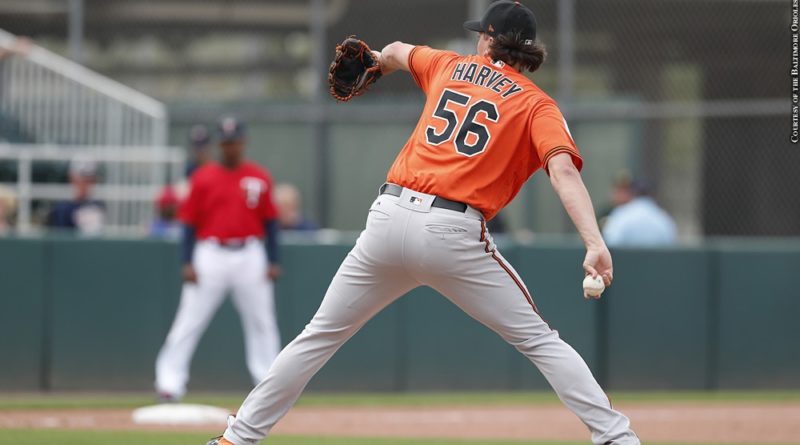The Baltimore Orioles’ bullpen was the best in Major League Baseball for a brief stretch in 2019.
From Aug. 20-Sept. 4, Orioles relievers allowed 11 earned runs in 44 innings for a 2.25 ERA, which ranked first in baseball during that time and provided a glimmer of hope for more effective performances in 2020. The emergence of right-hander Hunter Harvey as a potential closer added to that optimism.
Overall, the Orioles set the all-time MLB record by allowing 305 home runs this season and had a league-worst 5.59 ERA, just behind the Colorado Rockies (5.56) and Detroit Tigers (5.24). One of the main goals for this offseason and Phase Two of the rebuild will be putting together a stronger bullpen.
“Everybody knows that to be competitive in this league, in this division, you have to have pitching and you have to have guys that are able to throw strikes,” Orioles manager Brandon Hyde said. “You have to have bullpen guys be able to come in and shut the door down, hold leads and keep you in the game. I feel at some point we will get to that.”
The Orioles are going to need stronger production from the bullpen next season, especially if the starting pitchers continue to struggle.
“In the bullpen, a guy could have a really good year one year and then a really bad year the next, and vice versa,” Hyde said. “I don’t think our pitching numbers lie. We are who we are right now and we’ve given up a million home runs. It’s just something we have to get a lot better at.”
Hyde expects Harvey to play a key role in the potential resurgence of the bullpen. Harvey made his debut Aug. 17 and immediately became one of the team’s most effective pitchers. He appeared in seven games (6.1 innings), allowing just one run and three hits with 11 strikeouts and one walk. Harvey had a 1.42 ERA and 1.105 WHIP.
“The games that Hunter pitched, he lengthened out our bullpen. … He went out one time to finish an inning with a strikeout, and every other time I pitched him with a clean inning,” Hyde said. “It allows guys to fall into roles when there’s guys doing their jobs.”
Overall, Harvey pitched 82 innings between the Orioles’ minor-league affiliates and with the major-league club before being shut down Sept. 19 with biceps soreness. After battling injuries for most of his young career, Harvey, who turns 25 in December, and the Orioles were encouraged he was able to stay healthy for much of the season.
That should bode well for his confidence heading into spring training.
“All in all, I think it’s been a good year, so I’m happy with it,” Harvey said. “I finally just got out of that crazy little snowball I was in. I worked hard again this past offseason, just trying to prepare, get my body right, and it finally just held up.”
While Harvey could have a defined role next season, several other pitchers need to show more consistency.
Potential relievers on the 40-man roster include right-handers Miguel Castro, Mychal Givens, Evan Phillips, Branden Kline and Dillon Tate and lefties Richard Bleier, Paul Fry and Tanner Scott. The Orioles also have some prospects who could evolve into key contributors to the bullpen, including right-handers Zach Pop, Dean Kremer, Michael Baumann and lefties Keegan Akin and Bruce Zimmermann. Pop is recovering from Tommy John surgery, while the other four are currently being developed as starters.
Tate, who excelled in relief at Double-A Bowie and Triple-A Norfolk, could be a key middle reliever next season. Scott could emerge as a weapon against left-handed hitters. Castro could be used as the set-up man for the closer, potentially Harvey.
Givens was expected to be the de facto closer in 2019, but he lost that job after some struggles. He finished the season 2-6 with 11 saves, posting a 4.47 ERA, 1.190 WHIP, 86 strikeouts and 26 walks.
During a four-game stretch from Sept. 14-21, he allowed eight runs (seven earned) and six hits, including three home runs, and had two blown saves in 3.2 innings. He recovered at the end of the month and threw 2.2 scoreless innings to close out the year.
Givens said he didn’t notice much of a difference physically between effective and ineffective stretches.
“Just go out there and just try to attack hitters and just try to be myself,” he said. “Being yourself and being confident and being able to control the count is a big contributor to having success.”
Bleier was one of the Orioles’ most effective relievers in 2018 before a lat tear ended his season. It took some time for him to appear completely comfortable on the mound in 2019. Bleier went 3-0 with a 5.37 ERA throughout 53 games (55.1 innings) and notched his first career save Aug. 2 against the Toronto Blue Jays. He also had a confrontation with third base coach Jose Flores during the Orioles’ 8-4 loss to the Washington Nationals Aug. 28.
“I think I just let frustration kind of boil over, some stuff about some balls that I thought maybe … defensive positioning, I guess,” Bleier told the media after the game. “I probably could have done better for myself to keep my mouth shut, and unfortunately, I may have said something. You guys saw the rest.”
Though attendance at Camden Yards fell 19 percent from 1.6 million in 2018 to 1.3 million this year, Orioles general manager Mike Elias is confident the fans will return when he finishes the process of building a perennial winning team.
“The people coming out here, they love this team,” Elias said. “The people in this city love this team. They know that this needs to be done. I’m confident that they’re going to come back, and they’re going to come back in a big way.”
Photo Credit: Courtesy of the Baltimore Orioles
Issue 258: October 2019

